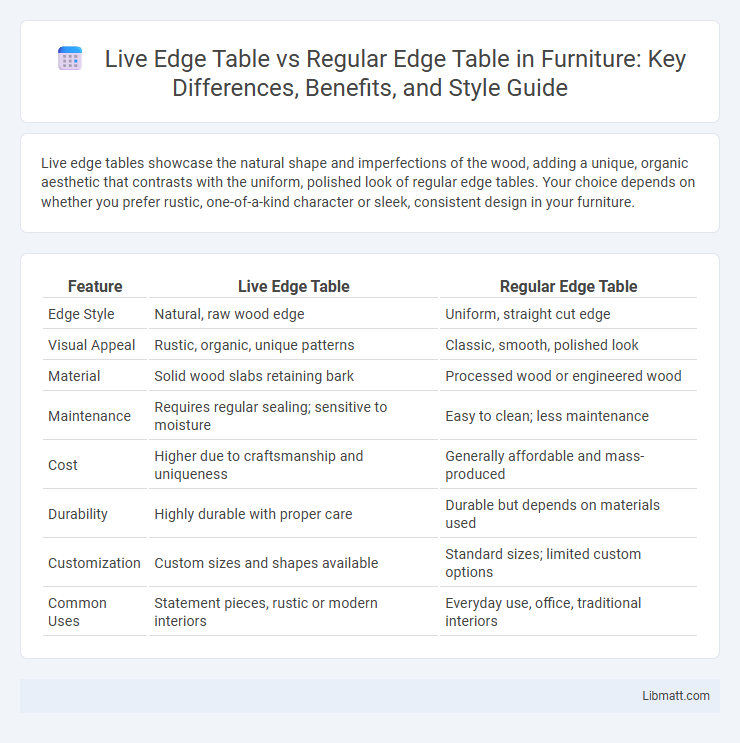Live edge tables showcase the natural shape and imperfections of the wood, adding a unique, organic aesthetic that contrasts with the uniform, polished look of regular edge tables. Your choice depends on whether you prefer rustic, one-of-a-kind character or sleek, consistent design in your furniture.
Table of Comparison
| Feature | Live Edge Table | Regular Edge Table |
|---|---|---|
| Edge Style | Natural, raw wood edge | Uniform, straight cut edge |
| Visual Appeal | Rustic, organic, unique patterns | Classic, smooth, polished look |
| Material | Solid wood slabs retaining bark | Processed wood or engineered wood |
| Maintenance | Requires regular sealing; sensitive to moisture | Easy to clean; less maintenance |
| Cost | Higher due to craftsmanship and uniqueness | Generally affordable and mass-produced |
| Durability | Highly durable with proper care | Durable but depends on materials used |
| Customization | Custom sizes and shapes available | Standard sizes; limited custom options |
| Common Uses | Statement pieces, rustic or modern interiors | Everyday use, office, traditional interiors |
Introduction to Live Edge vs Regular Edge Tables
Live edge tables showcase natural wood edges preserved from the tree's original shape, highlighting unique grain patterns and organic contours, while regular edge tables feature smooth, uniformly cut edges for a more polished and consistent look. These design differences influence the aesthetic appeal, with live edge tables adding rustic and artistic character, and regular edge tables fitting seamlessly into modern and minimalist interiors. Choosing between them depends on your preference for natural authenticity versus sleek symmetry in furniture design.
Defining Live Edge Tables
Live edge tables showcase the natural contours and organic shapes of wood slabs, preserving the bark or uneven edges for a rustic, one-of-a-kind look. Unlike regular edge tables, which feature smooth, uniformly cut edges, live edge tables emphasize the natural beauty and imperfections of the wood grain. Your choice of a live edge table brings warmth and authenticity to any space, making it a striking focal point in interior design.
Defining Regular Edge Tables
Regular edge tables feature smooth, straight edges created through precise trimming and finishing, offering a clean, uniform appearance. These tables emphasize consistency and symmetry, often crafted from kiln-dried hardwoods like maple or oak to enhance durability and stability. The consistent edge design makes regular edge tables versatile for various interior styles, providing a polished and contemporary look.
Aesthetic Differences
Live edge tables showcase the natural contours and imperfections of the wood, creating a unique, organic aesthetic that highlights the grain and texture, unlike regular edge tables which feature smooth, uniform edges for a cleaner, more polished look. This raw and rustic appeal of live edge designs adds character and warmth to your space, making each piece truly one-of-a-kind. In contrast, regular edge tables offer a more contemporary and streamlined appearance, suitable for minimalist or modern interiors.
Material and Craftsmanship
Live edge tables showcase natural wood slabs retaining the original tree bark and grain patterns, highlighting premium hardwoods like walnut, oak, or maple, and requiring skilled craftsmanship to preserve the raw beauty while ensuring structural integrity. Regular edge tables typically feature uniformly cut and sanded wood or engineered materials, emphasizing precision in smooth finishes and consistency, often produced through mass manufacturing techniques. The choice between live edge and regular edge tables hinges on whether one values organic uniqueness and artisanal detail or sleek, standardized design and efficiency.
Durability and Maintenance
Live edge tables, crafted from natural wood slabs with the original bark or grain preserved, offer exceptional durability due to the use of solid hardwood, resisting wear and tear effectively. Regular edge tables, often made with engineered wood or veneers, require more frequent maintenance because their surfaces are prone to scratches and delamination over time. Proper sealing and conditioning enhance the longevity of live edge tables, while regular edge tables benefit from routine cleaning and protective finishes to maintain appearance and structural integrity.
Cost Comparison
Live edge tables typically cost more than regular edge tables due to the unique, natural shapes of the wood and the labor-intensive crafting process required to preserve the tree's original contours. Regular edge tables are made with uniform, straight edges that are easier and faster to produce, making them more budget-friendly. This price difference reflects not only material and workmanship but also the rarity and aesthetic value of live edge slabs.
Customization Options
Live edge tables offer unique customization options that showcase the natural contours and grain patterns of the wood, creating one-of-a-kind designs that highlight organic beauty. Regular edge tables provide more uniform shapes and sizes, allowing for precise cuts, consistent polish, and easier integration into modern or traditional interiors. Your choice depends on whether you prefer the individuality and artistic flair of live edges or the sleek, predictable lines of regular edges.
Environmental Impact and Sustainability
Live edge tables often utilize slabs of wood with minimal processing, preserving the natural shape and bark, which reduces waste and extends the lifecycle of reclaimed wood, enhancing sustainability. Regular edge tables typically require more machining and cutting, producing more wood waste and consuming higher energy in manufacturing, contributing to a larger environmental footprint. Choosing a live edge table aligns with your commitment to eco-friendly furniture by supporting sustainable forestry practices and reducing resource consumption.
Choosing the Right Table for Your Space
Live edge tables showcase the natural, organic contours of wood, creating a unique centerpiece that adds rustic charm and character to any room. Regular edge tables offer clean, uniform lines and a polished finish, making them versatile for modern and minimalist decor styles. Your choice depends on whether you prefer the authenticity and texture of natural wood or the sleek, consistent look of manufactured edges.
live edge table vs regular edge table Infographic

 libmatt.com
libmatt.com